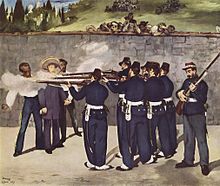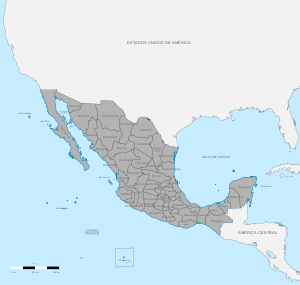Empire of Mexico (1864–1867)
| Imperio Mexicano | |||||
| Mexican Empire | |||||
| 1864-1867 | |||||
|
|||||
|
Motto : Equidad en la Justicia ( Spanish for "Justice in Justice" ) |
|||||
| Official language | Spanish | ||||
| Capital | Mexico city | ||||
| Form of government | Empire | ||||
| Head of state | Emperor Maximilian I (1864–1867) |
||||
| Head of government |
Regent Juan Almonte (1863–1864) |
||||
| surface | 1,972,550 km² | ||||
| population | 8,264,213 | ||||
| Population density | 4.2 inhabitants per km² | ||||
| currency | Mexican peso | ||||
| National anthem |
Himno Nacional Mexicano |
||||
| The second Mexican Empire | |||||
The Empire of Mexico ( Spanish Imperio Mexicano ) existed from 1864 to 1867 on the territory of what is today the United Mexican States . At no point did it control the entire territory. The empire came into being when Napoleon III. intervened in Mexico to establish a monarchy dependent on France . For it was Archduke Ferdinand Maximilian, the younger brother of Emperor Franz Joseph I of Austria, when Emperor Maximilian I used. The monarchy was abolished after the emperor's execution on June 19, 1867, and the Mexican Republic, which had existed all along and controlled parts of the country, regained its authority.
prehistory

After the end of the civil war and the defeat of the Conservatives, Mexico's economy fell to the ground. Thereupon the parliament decided on July 17, 1861 to stop the repayment of foreign debts. This called the European powers on the scene, above all France, which had already stationed troops in Mexico, since President Benito Juárez had the Spanish ambassador and the papal legate expelled.
To collect the debt, France, Spain and the United Kingdom signed the Treaty of London on October 31, 1861 . On December 8, 1861, the Spaniards began the invasion of Mexico and landed in Veracruz . The British and French followed between January 6 and 8, 1862. The intervention powers benefited from the Civil War , which prevented the United States from preventing the European invasion of America in accordance with its Monroe Doctrine .
When the other European powers realized that Napoleon III. when the aim was a dependent monarchy, they withdrew their forces. The French troops advanced single-handedly inland. After lengthy fighting, the French finally reached Mexico City and captured it on June 7, 1863. Thereupon a conservative junta was installed as government, which at the instigation of Napoleon III. Archduke Maximilian offered the imperial crown. In return, he renounced all hereditary claims to the throne in the Austrian Empire .
development
Despite the concerns of his family, Maximilian accepted the dignity of Emperor on April 10, 1864 on the condition that the Mexican people should vote on it. However, the French falsified the election result and made Maximilian believe that he was wanted by the Mexican people. Napoleon III assured the Habsburgs that the Mexicans would want nothing more than an emperor from the Austrian ruling house. However, at this point in time, Benito Juárez was again proclaimed President of Mexico. A successful land reform made it popular with many Mexicans.
When Maximilian and his wife Charlotte , daughter of the Belgian King Leopold I , arrived in Veracruz on May 29, 1864, the country was politically divided. Conservatives loyal to the emperor ruled the capital and the center of the country, while the Liberals under President Juárez controlled northern Mexico. The Conservatives were supported by European rulers, alongside Napoleon III. especially Isabella II of Spain . After the end of the American Civil War in 1865, the Liberals received support from US Presidents Abraham Lincoln and Andrew Johnson, as well as from other states on the American continent. The imperial couple was received only by a few conservative monarchists and had to fight their way to the capital under adverse circumstances while the struggle between the two political camps continued.
Maximilian was seen as a puppet of the French and tried to underpin his legitimacy by adopting the grandchildren of the former Mexican emperor Augustin I and being appointed heir to the throne. With the appointment of the former dictator Antonio López de Santa Anna as Reich Marshal, he also tried to expand his power base. According to the conservatives, the emperor was too liberal, but according to the liberals, Maximilian's government was too conservative.
From 1866 onwards the United States increased pressure on France and pushed for troops to be withdrawn from Mexico. Thereupon Maximilian turned to other European powers and asked for military assistance against President Juárez, whose sphere of influence increased. France withdrew François-Achille Bazaine ( Marshal of France from September 5, 1864 ) and his troops from Mexico in 1866 (Bazaine had been in Mexico since 1863).
On May 14, 1867, the emperor was finally disempowered. He was sentenced to death and shot on June 19, 1867 together with his generals Miguel Miramón and Tomás Mejía at "Tres Campanas", Querétaro. Empress Charlotte escaped death because she was in Europe to meet Napoleon III. and Pius IX. (Pope from 1846 to 1878) asking for help.
Territory parts
In 1865 the Mexican Empire was divided into the following 50 departments:
Museum reception
The brief history of the Mexican Empire is documented in detail in the Vienna Army History Museum . So are u. a. the death mask of the Emperor, the standard of the Imperial Mexican Husaren - regiment (1865-1867) and a cartridge for officers of the cavalry the Austrian-Mexican volunteers Brigade (1864-1867) issued.
Individual evidence
- ^ Liselotte Popelka: Army History Museum Vienna. Publishing house Styria, Graz u. a. 1988, ISBN 3-222-11760-8 , p. 59.
- ^ Manfried Rauchsteiner , Manfred Litscher (Ed.): The Army History Museum in Vienna. Publishing house Styria, Graz u. a. 2000, ISBN 3-222-12834-0 , p. 55.
literature
- Arnold Blumberg: The Diplomacy of the Mexican Empire, 1863-1867. Reprinted edition. Krieger, Malabar FL 1987, ISBN 0-89874-931-X .
- René Chartrand: The Mexican Adventure 1861–67 (= Men-at-arms Series. 272). Osprey, London 1994, ISBN 1-85532-430-X .
- Thomas Edelmann: "Better things go wrong than not at all". Maximilian's Empire in Mexico 1864-1867 , in: Annual Report 2017 of the Heeresgeschichtliches Museum (Vienna 2018), ISBN 978-3-902551-81-8 , pp. 35-48
- Johann Lubienski: The Maximilianeische state. Mexico 1861–1867. Constitution, administration and history of ideas (= research on European and comparative legal history. 4). Böhlau, Vienna et al. 1988, ISBN 3-205-05110-6 (also: Cologne, University, dissertation, 1983).
- Jan Schlürmann : "In my kingdom, the sun never sets" - Reloaded. Three monarchical restoration projects in Latin America around 1864. In: Oliver Auge , Ulrich Lappenküper , Ulf Morgenstern (eds.): The Vienna Peace 1864. A German, European and global event (= Otto von Bismarck Foundation. Scientific series. Vol. 22). Ferdinand Schöningh, Paderborn 2016, ISBN 978-3-506-78525-1 , pp. 321-345, ( digitized version ).
- Friedrich Weissensteiner : reformers, republicans and rebels. The other house of Habsburg-Lothringen (= Piper. 1954). Piper, Munich et al. 1995, ISBN 3-492-11954-9 .
Web links
- Empire of Mexico (English)
- Empire of Mexico (English)
- Mexico: The French Intervention and the Second Empire, 1862-1867. (English)






